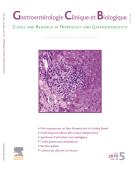The place of endoscopic ultrasound in bilio-pancreatic pathology - 27/09/10
Summary |
The place of endoscopic ultrasound (EUS) in malignant pathology of the pancreas is two-fold: (1) EUS is the best examination for the diagnosis of small tumours (<3cm in diameter). Its sensitivity is greater than that of CT scan, percutaneous ultrasound or magnetic resonance imaging (MRI) and is equal to that of endoscopic retrograde cholangiopancreatography (ERCP) without sharing its invasive character; (2) EUS is also indicated in the assessment of locoregional extension of tumours judged resectable by tomodensitometric (TDM) (scanner) data. The performance of EUS seems to be greater than other imaging techniques for the diagnosis of vascular and lymph node invasion although recent studies report less good results than those of studies in 1992 to 1994, particularly for vascular involvement. Nevertheless, EUS cannot affirm the malignant or benign character of these pancreatic masses. The development over the last 20 years of linear sector-based EUS has enabled us to perform guided biopsies of such lesions. EUS-guided biopsy is today the best technique for obtaining the histology of a pancreatic mass, with a sensitivity of 85 to 87%. Furthermore, it also has a non-negligible impact on the deciding the treatment particularly in the case of adenocarcinomas (ADKP) not visible to TDM (scanners). This is currently of importance because trials are being developed of preoperative radio-chemotherapy for resectable lesions. probably in the next future, contrast-enhanced EUS (CE-EUS) and elastography will improve the results of EUS and will be necessary for a precise local staging before treatment.
Il testo completo di questo articolo è disponibile in PDF.Mappa
Vol 34 - N° 8-9
P. 436-445 - Settembre 2010 Ritorno al numeroBenvenuto su EM|consulte, il riferimento dei professionisti della salute.


